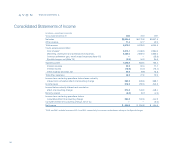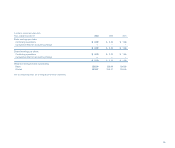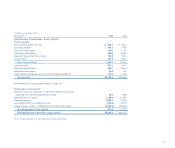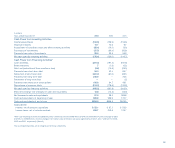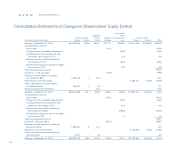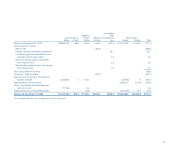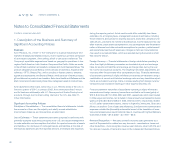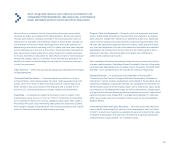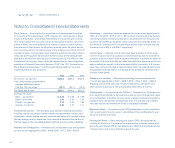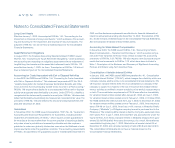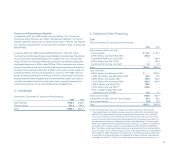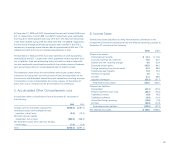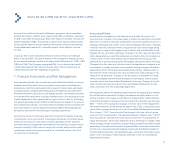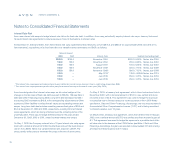Avon 2003 Annual Report Download - page 43
Download and view the complete annual report
Please find page 43 of the 2003 Avon annual report below. You can navigate through the pages in the report by either clicking on the pages listed below, or by using the keyword search tool below to find specific information within the annual report.
In millions, except per share data
1. Description of the Business and Summary of
Significant Accounting Policies
Business
Avon Products, Inc. (“Avon” or the “Company”) is a global manufacturer and
marketer of beauty and related products. Avon’s business is primarily comprised
of one industry segment, direct selling, which is conducted worldwide. The
Company’s reportable segments are based on geographic operations in four
regions: North America, Latin America, Europe and the Pacific. Sales are made
to the ultimate customers principally by independent Avon Representatives. The
product categories include Beauty, which consists of cosmetics, fragrance and
toiletries (“CFT”); Beauty Plus, which consists of fashion jewelry, watches,
apparel and accessories; and Beyond Beauty, which consists of home products,
gift and decorative products and candles. Sales from Health and Wellness and the
Mark. brand are included among these three categories based on product type.
Avon launched a retail brand, beComing, in J.C. Penney stores in the U.S. in
the third quarter of 2001. In January 2003, Avon announced that it would
end its business relationship with J.C. Penney and sell the beComing line of
products through Avon’s direct selling channel in the U.S. (see Note 17,
Other Information).
Significant Accounting Policies
Principles of Consolidation — The consolidated financial statements include
the accounts of Avon and its majority and wholly-owned subsidiaries.
Intercompany balances and transactions are eliminated.
Use of Estimates — These statements have been prepared in conformity with
generally accepted accounting principles in the U.S. and require management
to make estimates and assumptions that affect the reported amounts of assets
and liabilities, the disclosure of contingent assets and liabilities at the date of
the financial statements and the reported amounts of revenues and expenses
during the reporting period. Actual results could differ materially from those
estimates. On an ongoing basis, management reviews its estimates, including
those related to allowances for doubtful accounts receivable, allowances for
sales returns, provisions for inventory obsolescence, income taxes and tax valu-
ation reserves, stock-based compensation, loss contingencies and the determi-
nation of discount and other actuarial assumptions for pension, postretirement
and postemployment benefit expenses. Changes in facts and circumstances
may result in revised estimates, which are recorded during the period in which
they become known.
Foreign Currency — Financial statements of foreign subsidiaries operating in
other than highly inflationary economies are translated at year-end exchange
rates for assets and liabilities and average exchange rates during the year
for income and expense accounts. The resulting translation adjustments are
recorded within Accumulated other comprehensive loss. Financial statements
of subsidiaries operating in highly inflationary economies are translated using a
combination of current and historical exchange rates and any translation adjust-
ments are included in earnings. Gains or losses resulting from foreign currency
transactions are recorded in earnings in Other expense (income), net.
Financial statement translation of subsidiaries operating in highly inflationary
economies and foreign currency transactions resulted in net losses (gains) of
$15.9, ($16.0) and $7.7 in 2003, 2002 and 2001, respectively, which are included
in Other expense (income), net. Included in these amounts are transaction losses
(gains) of $2.8, ($27.8) and ($8.0) in 2003, 2002 and 2001, respectively, related
to U.S. dollar denominated assets, mainly in Argentina, Venezuela, Brazil and
Mexico. In addition, Cost of sales and Marketing, distribution and administrative
expenses included the (favorable) unfavorable impact of the translation of inven-
tories and prepaid expenses at historical rates in countries with highly inflationary
economies in 2003 – ($1.0) (2002 – $.7; 2001 – $2.0).
Revenue Recognition — Net sales primarily includes sales generated as a
result of Representative orders less any discounts, commissions, taxes and
other deductions. Avon recognizes revenue upon delivery, when both title and
the risks and rewards of ownership pass to the independent Representatives,
Notes to Consolidated Financial Statements
notes to statements
62




